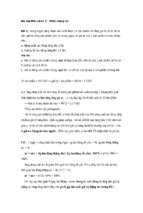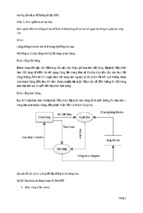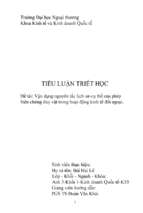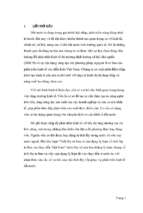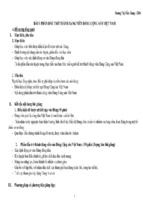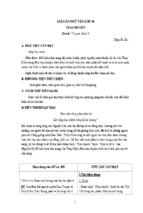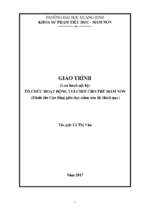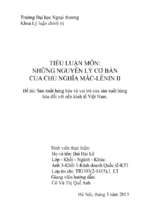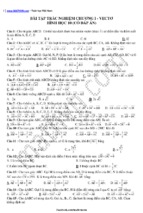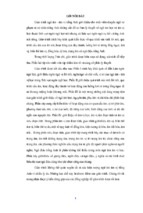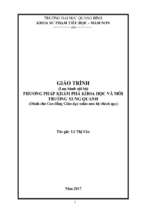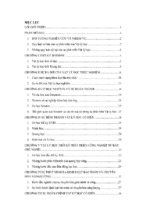LỜI NÓI ĐẦU
Giáo trình ngữ âm - âm vị tiếng Anh giới thiệu cho sinh viên chuyên ngữ sư
phạm và cử nhân tiếng Anh những vấn ñề cơ bản lý thuyết về ngữ âm học và âm vị
học thuộc lĩnh vực ngôn ngữ học nói chung và lĩnh vực ngôn ngữ cụ thể - tiếng Anh
nói riêng. Giáo trình trình bày khái quát kiến thức về quá trình sản sinh lời nói, quá
trình cấu âm của lời nói, hoạt ñộng của dây thanh, luồng hơi từ trong lồng ngực, âm
vị, biến thể âm vị, ñồng hóa, dị hóa, trọng âm và ngữ ñiệu tiếng Anh.
Trong thời lượng 2 tín chỉ, giáo trình ñược biên soạn cô ñọng, xúc tích dễ tiếp
thu. Phần bài tập cho sinh viên tập nhằm làm rõ và củng cố phần lý thuyết.
Giáo trình ñược kết cấu như sau: Phần I trình bày khái quát về dẫn luận ngôn
ngữ học, giới thiệu ngôn ngữ và lời nói, ngôn ngữ và chữ viết, vị trí của ngữ âm - âm
vị học trong lĩnh vực ngôn ngữ học. Phần II giới thiệu quá trình sản sinh lời nói, quá
trình cấu âm, hoạt ñộng dây thanh và hoạt ñộng của luồng hơi từ trong lồng ngực ñi
ra khoang miệng hoặc khoang mũi. Phần III là một trong những nội dung trọng tâm
của giáo trình giới thiệu về ngữ âm học, nguyên âm, phụ âm và các tiêu chí phân loại
chúng. Phần này cung cấp kiến thức về hoạt ñộng của cơ quan cấu âm, vị trí phát âm,
phương thức cấu âm, vị trí của lưỡi, ñộ nâng của lưỡi, hình dáng của môi và ñộ dài
ngắn của nguyên âm. Phần IV giới thiệu về âm vị học, âm vị âm ñoạn tính và âm vị
siêu ñoạn tính. Trong phần âm vị âm ñoạn tính, giáo trình giới thiệu âm vị, biến thể
âm vị, biến thể tự do, một số quy luật về ñồng hóa, hiện tượng dị hóa, âm tiết hóa, âm
nối... Trong phần siêu ñoạn tính, giáo trình tập trung trình bày các mục về âm tiết có
trọng âm, âm tiết không trọng âm, trọng âm từ, vị trí trọng âm từ, chức năng của
trọng âm, các phương thức nghiên cứu trọng âm từ góc ñộ người phát ngôn và người
nghe; Ngữ ñiệu tiếng Anh là phần không thể thiếu trong môn ngữ âm âm vị học.
Phần này giới thiệu về giọng ñiệu, ngôn ñiệu và ngữ ñiệu, ý nghĩa và các hình thức
biểu thị của ngữ ñiệu cũng như các chức năng của chúng.
Giáo trình không thể quán xuyến tất cả các hiện tượng ngữ âm âm vị tiếng
Anh vì nhiều lý do. Những hạn chế này là nhược ñiểm của giáo trình. Chúng tôi rất
mong nhận ñược ý kiến ñóng góp của các ñồng nghiệp ñể giáo trình ñược tốt hơn.
1
Introduction
It is believed when we are speaking a foreign language there are times when
the other person does not understand us, or we do not understand the other person.
This case is called a communication breakdown. Sometimes communication
breakdown is due to a grammar or vocabulary mistake and sometimes it is due to a
pronunciation mistake. As we need to be able to analyze and correct our grammar
and vocabulary mistakes we need to be able to analyze and correct our pronunciation
mistakes.
In pronunciation, it is not necessary to pronounce every sound perfectly to be
understood – only a few parts of each sentence are really important, but these parts
are essential. The native speaker depends on hearing these parts clearly; therefore we
need to know which parts of a sentence must be clear and how to make them clear.
As the sound systems of English and Vietnamese differ greatly, Vietnamese speakers
can have quite severe pronunciation problems. Vietnamese is a tone language; that is,
pitch changes distinguish word meaning. Most words in Vietnamese consist of only
one syllable; there are fewer consonants than in English and there are no consonant
clusters. On the other hand, the Vietnamese vowel system makes a large number of
distinctions. Vietnamese uses a modified Roman alphabet but many of the letters
have quite different sound values from those of English.
This course cannot be learned in a few days. If we tried to cover all of these topics
quickly, the result would be little more than a dry terminological list with brief
definitions, accompanied by a few diagrams and an abstract discussion of the
associated theories. It would not be especially useful for us to require you to
memorize these terms with learning anything much about the underlying realities.
Instead of giving a tour of the whole of English phonetics and phonology, this
portion has two more limited goals. The first goal is to put language sound structure
in context. Why do human languages have a sound structure about which we need to
say anything more than that vocal communication is based on noises made with the
eating and breathing apparatus? What are the apparent "design requirements" for this
system, and how are they fulfilled? The second goal is to give you a concrete sense of
what the language sound systems are like. In order to do this, we will go over, in a
certain amount of detail, a few aspects of the phonetics and phonology of English,
and also a bit about the contrastive phonetics and phonology of the Vietnamese
language, a language spoken in our country, Vietnam. Along the way, a certain
amount of the terminology and theory of phonetics and phonology will emerge.
The first part of the course presents briefly introduction to language, to
explaine speech and language, sounds and speech, writing, language and grammar,
and phonetics and linguistics. Unit II deals with the production of speech sounds
through the speech chain, the speech mechanism, the vocal cords and the airstream.
In Unit III, the English sounds are mainly presented. Unit IV is concerned with
English phonology. Segmental phonology and suprasegmental phonology are
emerged in this last part, and they cover the main subject matters of the course such
as phonemes, allophones, minimal pair, minimal set, free variation, transcription as
well as sounds in connected speech. Unit IV ends with matters dealing with weak
forms, the English stress and intonation.
2
TABLE OF CONTENTS
LỜI NÓI ĐẦU........................................................................................................................................ 1
INTRODUCTION ............................................................................................................................... 2
TABLE OF CONTENTS .............................................................................................................................. 3
CHAPTER I
A BRIEF INTRODUCTION TO LANGUAGE ............................. 5
1.1 LANGUAGE AND SPEECH ........................................................................................................... 5
1. 2 SOUNDS AND SPEECH................................................................................................................. 5
1.3 WRITING.......................................................................................................................................... 5
1.4 LANGUAGE ...................................................................................................................................... 6
1.5 GRAMMAR........................................................................................................................................ 7
1.6 THE DIFFERENCES BETWEEN SPEECH AND LANGUAGE .................................................. 8
1.7 PHONETICS AND LINGUISTICS ............................................................................................... 10
CHAPTER
II
ENGLISH PHONETICS .......................................................................... 14
2.1 THE STUDY OF HOW ORGANS OF SPEECH WORK IN PRODUCING SPEECH SOUNDS14
2.2 PHONETIC ASPECTS.................................................................................................................. 15
2.3 THE PRODUCTION OF SPEECH SOUNDS.............................................................................. 18
2.4 THE SPEECH CHAIN................................................................................................................... 20
2.5 THE SPEECH MECHANISM (ARTICULATORS) ..................................................................... 21
2.6 THE VOCAL CORDS ..................................................................................................................... 22
2.7 THE AIR STREAM .......................................................................................................................... 25
CHAPTER
III
THE ENGLISH SOUNDS ....................................................................... 27
3.1 THE ENGLISH VOWELS ............................................................................................................. 27
3.2 THE ENGLISH CONSONANTS ................................................................................................... 30
CHAPTER
IV
ENGLISH PHONOLOGY ....................................................................... 37
4.1 SEGMENTAL PHONOLOGY ........................................................................................................ 37
4.1.1 Minimal Pairs .................................................................................................................... 38
4.1.2 Minimal set.......................................................................................................................... 38
4.1.3 Phonemes – contrastive phonemes ........................................................................... 39
4.1.4 Allophones – non-contrastive phonemes ................................................................ 39
4.1.5 Free Variation ................................................................................................................... 40
4.1.6 The Transcription ............................................................................................................. 40
4.1.7 The Description ................................................................................................................. 41
4.2 SOUNDS IN CONNECTED SPEECH (GENERAL PHONOLOGICAL RULES) ................ 42
4.2.1 Assimilation ........................................................................................................................ 48
4.2.2 Types of assimilation:..................................................................................................... 48
4.2.3 Basic Rules of Assimilation ........................................................................................ 49
4.2.4 Degrees of Assimilation................................................................................................. 50
4.2.5 The Elision........................................................................................................................... 50
4.2.6 Liaison (sound linking) .................................................................................................. 52
4.3 SUPRA-SEGMENTAL PHONOLOGY ....................................................................................... 54
4.3.1Weak forms ........................................................................................................................... 55
4.3.2 Vowel reduction in English .......................................................................................... 55
3
4.3.3 Alternation ........................................................................................................................... 58
4.3.4 The English Stress ............................................................................................................ 58
4.3.5 Stress is as an intonation unit ..................................................................................... 59
4.3.6 Word stress ........................................................................................................................ 60
4.3.7 Types of word stress ........................................................................................................ 61
4.3.8 Function of word stress ................................................................................................. 62
4.3.9 Stress in phrasal verbs ................................................................................................... 63
4.3.10 Secondary stress ............................................................................................................. 64
4.3.11 Degrees of stress in English ...................................................................................... 64
4.3.12Tonic Stress........................................................................................................................ 66
4.3.13 Emphatic Stress .............................................................................................................. 67
4.3.14 Contrastive Stress .......................................................................................................... 67
4.3.15 New Information Stress ............................................................................................... 68
4.4 RHYTHM IN ENGLISH ................................................................................................................. 68
4.5 THE ENGLISH INTONATION ..................................................................................................... 70
4.5.1 Intonation Units ............................................................................................................... 71
4.5.2 Tone ........................................................................................................................................ 72
4.5.3 Functions of Intonation ................................................................................................ 77
4.5.4 Attitudinal function......................................................................................................... 77
4.5.5 Grammatical function..................................................................................................... 77
4.5.6 Accentual function .......................................................................................................... 78
4.5.7 Interactive function approaches (discourse function)..................................... 78
APPENDIXES...................................................................................................................................... 81
APPENDIX 1. ASSIMILATION ...................................................................................................... 81
APPENDIX 2 GLOSSARY TO PRONUNCIATION TERMS AND TERMINOLOGY ................ 87
REFERENCES .................................................................................................................................... 91
4
CHAPTER I
A BRIEF INTRODUCTION TO LANGUAGE
1.1 Language and Speech
The purpose of speaking is to convey meaningful ideas to the listener. In order
to do this, the listener should be able to interpret the meaning of the spoken sounds.
One way of doing this is by providing a coding mechanism with set of rules enabling
the listener to interpret the meaning of the speech. The human being uses linguistics
as the tool for coding the information. The coding mechanism is not straightforward.
The new ideas are converted into linguist structure. This requires selection of
appropriate words, phrases. These words are ordered in sequence according to
grammatical rules.
1. 2 Sounds and speech
From the linguistic point of view the smallest speech unit is known as
phonemes, which indicates a different in meaning and is normally written between
slashes as for example /m/ in hum. In fact the sounds produced for individual
phonemes vary depending on where it appears in a word, phonemes sets are different
for different languages, as for example about 44 phonemes are sufficient to
discriminate between all the sounds made in British English.
Phonemes are characterized into six different groups. These are the vowels,
diphthongs, semi vowels, stop, fricative and affricative consonants. The grouping of
these phonemes is based on the way these sounds are produced. Each phoneme is a
combined version of the first three dominant formant frequency which is originated
due to the vibration of the vocal cord. However the formant frequency largely varies
depending on the speaker.
One of the chief characteristics of the human being is his ability to
communicate to his fellows complicated messages concerning every aspect of his
activity. A man possessing the normal human faculties achieves this exchange of
information mainly by means of two types of sensory stimulation, auditory and
visual. The child will learn from a very early age to respond to the sounds and tunes
which his elders habitually use in talking to him; and a need to communicate, he will
himself begin to imitate the recurrent sound patterns with which he has become
familiar. In other words, he begins to make use of speech; and his constant exposure
to spoken form of his own language, together with his need to convey increasingly
subtle types of information, leads to a rapid acquisition of the framework of his
spoken language. Nevertheless, with all the conditions in his favor, a number of years
will pass before he has mastered not only the sound system used in his community
but also has at his disposal a vocabulary of any extent or is entirely familiar with the
syntactical arrangements in force in his language system. It may be said that, as we
grow older, the acquisition of a new language will normally entail a great deal of
conscious, analytic effort, instead of the child’s ready and facile imitation.
1.3 Writing
Later in life the child will be taught the conventional visual representation of
speech, he will learn to use writing. Today, in considering those languages which
5
have long possessed a written form, we are apt to forget that the written form is
originally an attempt at reflecting the spoken language and that the latter precedes the
former for both the individual and the community. Indeed, in many languages, so
parallel are the two forms felt to be that the written form may be responsible for
changes in pronunciation or may tend to impose restraints upon its development. In
the case of English, this sense of parallelism may be encouraged by the obvious lack
of consistent relationship between sound and spelling. A written form of English,
based on the Latin alphabet, has existed for more than 1,000 years and, though the
pronunciation of English has been constantly changing during this time, few basic
changes of spelling have been made since the fifteenth century. The result is that
written English is often inadequate and misleading representation of the spoken
language of today. Clearly it would be unwise, to say the least, to base our judgments
concerning the spoken language on prejudices derived from the orthography.
Moreover, if we are to examine the essence of the English language, we must make
our approach through the spoken rather than the written form. Our primary concern
will be the production, transmission, and reception of the sounds of English, in other
words, the Phonetics of English.
1.4 Language
It is clear that the analysis of the spoken form of English is by no means
simple. Each of us uses an infinite number of different speech sounds when speaking
English. Indeed, it is true to say that it is difficult to produce two sounds which are
precisely identical from the point of view of instrumental measurement: two
utterances by the same person of the word “cat” may well show quite marked
differences when measured instrumentally. Yet we are likely to say that the same
sound sequence has been repeated. In fact we may hear clear and considerable
differences of quality in the vowel of “cat” as in the London and Manchester
pronunciation of the word; yet, though we recognize differences of vowel quality, we
are likely to feel that we are dealing with a variant of the same vowel.
It seems that we are concerned with two kinds of reality: the concrete,
measurable reality of the sounds uttered, and another kind of reality, an abstraction
made in our minds, which appears to reduce this infinite number of different sounds
to a manageable number of categories. In the first concrete, we are dealing with
sounds in relation to speech; at the second, abstract, our concern is the behavior of
sounds in a particular language.
A language is a system of conventional signals used for communication by a
whole community. This pattern of conventions covers a system of significant sound
units (the phonemes), the inflexion and arrangement of ‘words’, and the association
of meaning with words. An utterance, an act of speech, is a single concrete
manifestation of the system at work. As we have seen, several utterances which are
plainly different on the concrete, phonetic level may fulfill the same function on the
systematic language level. It is important in any analysis of spoken language to keep
distinction in mind and we shall later be considering in some detail how this dual
approach to utterance is to be made. It is not, however, always possible or desirable
to keep the two level of analysis entirely separate: will draw upon our knowledge of
the linguistically significant units to help us in determining how speech continuum
6
shall be divided up on the concrete, phonetic level; and our classification of linguistic
units will be helped by our knowledge of their phonetic features.
It is obvious that language is the system of human communication by means of
a structured arrangement of sounds (or their written representation) to form larger
units, e.g. Morphemes, words, sentences. In common usage it can also refer to nonhuman systems of communication such as the language of bees, the language of
dolphin. The possession of language distinguishes humans from other animals.
Today, linguists agree that the knowledge of a language is that of something
quite abstract: it is a knowledge of rules and ways of saying and doing things with
sounds, words, and sentences without any guiding principles for their use. It is
knowing what is in the language and what is not; it is knowing the possibilities the
language offers and what is impossible. This knowledge explains how it is we can
understand sentences we have not heard before and reject others as ungrammatical: in
the sense of without being possible in the language. Communication among people is
possible because such a knowledge is shared or even how it is acquired, - is not well
understood.
The knowledge of a language is an internalized system of many things.
Probably without being aware of it, we know the sounds that are part of our language
as well as those are not. Knowledge of the sound patterns also includes knowing
which sounds may start a word, end a word, and follow each other. This,
nevertheless, constitutes only one part of our linguistic knowledge. Another
important part is knowing that certain sounds and sound sequences signify or
represent different concepts or “meaning”. Note not all strings of words make sense
in a language. Our linguistic knowledge enable us to form larger and larger sentences
by joining words into phrases, phrases into clauses, clauses into sentences, and
sentences into discourses. There is a difference between having the necessary
knowledge to produce sentences in a language and the way we use this knowledge in
linguistic performance or behavior. In fact, our linguistic knowledge works on two
levels: What we know linguistic competence and how we use this knowledge in
actual behavior- linguistic performance.
1.5 Grammar
A language consists of all the sounds, words, and possible sentences. When
we know a language, we know the sounds, the words, and the rules for their
combination. The elements and rules constitute the grammar of a language. Grammar
represents our linguistic competence.
According to Victoria Fromkin (1984), the grammar includes the sound
system, called phonology, the system of meaning, called semantics, the rules of
words formation, called morphology; and rules of sentence combination, called
syntax. It also includes the rules of act of communication, called discourse.
Every human who speaks a language knows the grammar of that language.
Chomsky maintains that a native speaker has somewhere in his/ her brain a set of
grammar rules which s/he uses to make sentences with. This by no means that s/he
can tell us what the rules are, or rather how that language works, grammatically. Of
course there may be some differences between the knowledge that one speaker has
7
and of another, there must be shared knowledge because it enables speakers to talk to
and to understand one another.
There are two types of grammar. A description of the grammar is called
Descriptive Grammar- it describes how a language is actually spoken and or written;
it explains how it is possible for us to speak and understand speech; it does not state
what is right or what is wrong; neither does it evaluate what is better nor prescribes
how the language ought to be spoken or written, but it describes what is happening in
the language.
Prescriptive Grammar prescribes rules for what is considered the best or the
most correct usage. It is based on the grammarians’ view of what is best. Prescriptive
grammar does not help speakers learn their language, but rather, it is an aid in foreign
language teaching, or keeps a language in a country in uniform.
When talking all the aspects of grammar into consideration, linguists have
identified some properties that all natural language share: systematic, arbitrary, and
conventional; without these characteristics, communication among humans would
hardly be possible.
1.6 The differences between speech and language
When observing a group of people engaged in a conversation you witness
several kinds of communication. There is first of all the voice, with all its complexity
and richness of intonation and other modulation. There is also a tapestry of gestures,
including hand waving of various sorts, body stance, gaze, and other facial
movements. These combine to communicate intention.
The ordinary vehicle of linguistic communication is the voice, and speech is a
primary mode of human language. This is so hardly surprising for speech has several
advantages over other vehicles of human communication. It is extremely valuable to
have a vehicle with other life-sustaining activities. Because speech does not need to
be seen, it can do its work as effectively in darkness as in light, around corners, and
in other visually inaccessible spots. Although in its natural state it cannot span time,
its physical reach is far greater than arm’s length. Unlike singing, speech leaves eyes
and the hands free for other work. We can talk and listen while looking at things
besides our interlocutors. In the development of speech in the human species, when
hands and eyes were occupied in hunting, fishing, food gathering, and other manual
activities of work and play, speech was free to carry out other tasks: to report, point,
ask for and give direction, explain, promise, bargain, warn.
Speech has still other advantages. For one thing, the human voice is a complex
vehicle with many channels. It has variable volume, pitch, stress, and speed: it is
capable of wide-ranging modulation. Speech is not a single channel mode. It has
intonation and stress, as well as the more familiar grammatical levels. Besides a set
of sounds, speech takes advantages of the organization of those sounds – of their
sequencing into words and sentences. Like wring and singing, speech can take
advantage of word choice and word order. Intonation, stress and volume are more
fully privileges of the spoken mode than of the written or signed modes.
Speech and writing are the two primary modes of linguistic communication,
each with advantages and limitations. For example, speech is the only modes of
linguistic communication possible when visibility is hindered. It is also the only
8
mode in which the communication’s hands and eyes are left free to do other things.
Speech has limitations too. Speech has an evanescent character and vanishes upon
being uttered unless it was tape-recorded or filmed.
Writing, on the other hand, has evolved to meet other needs. It can be
preserved for thousands of years. Writing has another advantage over speech in that it
can transcend space. One can send a written massage anywhere on earth. With
technology, of course, this advantage of writing over speech is decreasing.
1.6.1 Speech as Rule-Governed Language Use
There is much more to the ability to speak than grammatical competence.
Being as the elements of a language, speech is used to put together into well-formed,
or grammatical, sentences. Speech falls far short of knowing how to accomplish the
work that speakers accomplish with language, and falls short of native speaker
fluency. To be fluent in a language requires not only mastery of its grammatical rules
but also competence in the appropriate use of the sentences that are structured by
those rules.
Fluency requires knowledge of how to put sentences together in conversation,
for example, and how to rely on nonlinguistic context and previous linguistic context
in shaping utterances appropriately, and in interpreting them. The point is that
fluency presumes two kinds of competence: knowledge of how to form sentences and
knowledge of what those sentences are capable of doing and of when and how to use
them appropriately (as well as how to interpret them in context). The capacity that
enables us to use language appropriately is called communicative competence. It
enables language users to weave utterances together into conversation, apologies,
requests, directions, descriptions,
Knowing a language presumes both communicative competence and
grammatical competence. To be fluent, grammatical competence and communicative
competence are jointly needed.
We can summarize by saying that grammatical competence is the language
user’s implicit knowledge of vocabulary, pronunciation, sentence structures and
meaning, while communicative competence is the implicit knowledge that underlies
the appropriate use of grammatical competence in the various situations of language
use. The rules that govern the appropriate use of language differ from one speech
community to the next, so even a shared grammatical competence may not be
adequate to make you a fluent speaker in another community, at least in some
situations.
1.6.2 Language as Rule-Governed Systems
Precisely because the relationship between linguistic symbols and the things
they represent is arbitrary, languages must be highly organized systems if they are to
function as reliable vehicles of expressions and communication. If there were no
pattern to the way we voiced our thoughts and feelings, listeners would face an
insuperable task in determining what we meant. If language were not highly
organized and patterned systems, listeners would find it impossible to unravel their
arbitrary symbols for the content they encode.
9
It is not surprising then that languages have evolved over centuries into such
extraordinary complex systems.
Language is rule governed. It follows observable patterns that obey certain
inherent rules. Such rules are not imposed from the outside, and they do not specify
how something should be done. Instead, they are merely the regularities that we can
observe being followed when people use language. In other words, the linguistic
rules described are based on nothing more than the observed regularities of language
behavior and of the underlying systems.
A language is a set of elements and a system of rules for combining those
elements to form patterned sentences that can be used to do specific jobs in specific
contexts.
Utterances report something, greet someone, invite a friend to lunch, request
the time of day, express admiration, propose marriage, create fictional worlds, and so
on in an endless list. And languages do this using a finite system of elements and
rules that a child normally masters in a few short years. The mental capacity that
enables speakers to form grammatical sentences is called grammatical competence.
In our course we focus on language as it is represented in spoken and written
communication. It is important to keep in mind that historically and developmentally,
writing is a secondary mode of linguistic communication. This can be a challenge to
you as students, whose principal focus and principal context for discussing language
has been written language.
Since speech and writing are the two modes of linguistic communication,
language is a system of grammatical rules that structured the organization of
expression. Equally important is the role of language as a tool that we use to
accomplish tasks with one another. Structure and use go hand in hand and correspond
to the dual function of language as an integral component of our mental functions
and as a tool in the regulation of social interactions.
Human language is a system primarily of arbitrary symbols, although certain
symbols are representational. Communication that involves language can take place
in any of two modes speech and writing.
To describe what language is, G.H. Lewes compares as follows “Just as birds
have wings, man has language. The wings give the birds its peculiar aptitude for
aerial locomotion. Language enables man’s intelligence and passions to acquire their
peculiar characters of intellect and sentiment.” Walt Whitman argues that “Language
is not an abstract construction of the learned, or of dictionary-makers, but is
something arising out of the work , needs, ties, joys, affections, tastes, of long
generations of humanity, and has its bases broad and low, close to the ground.” H.G
Widdowson points out language functions as follows “Language serves as a means of
cognition and communication; it enables us to think for ourselves and to cooperate
with other people in our community. It provides for present needs and future plans,
and at the same time carries with it the impression of things past”.
1.7 Phonetics and Linguistics
This course is primarily concerned with the sound system of English and it is
proper that phonetic and phonemic analysis should occupy an important place in the
study of any language. It should be remembered that phonetic analysis constitutes but
one step in a linguistic investigation. A complete description of the current state of a
10
language must provide information on several interrelated levels:(1) Phonology,- The concrete phonetic characteristics of the sounds used in the
language; the functional, phonemic behavior of these sounds for distinctive purposes;
the combinatory possibilities (syllabic structure) of the phonemes; the nature and use
of such prosodic features as pitch, stress and length. A study of the phonic substance
of the language may be accompanied by a description of the written form of the
language.
(2) Lexis - The total number of word forms which exist.
(3) Grammar - The system of rules governing the structures of phrases, clauses
and sentences consisting of words contained in the lexicon
(4) Semantics - The relation of meaning to the signs and symbols of language.
(5) Other aspects of language which would require investigation include the
variation of the same language in different regions and social classes (dialectology);
the influence of context and style upon the form and substance of the language; the
behavior of human beings in their production and perception of the language
(psycholinguistics); the interaction of the language and the society in which it is
spoken (socio-linguistics).
Finally, it is clear that the phonology, lexis, grammar and semantics of a language
are always undergoing change in time. The state of a language at any moment must
be seen against a background of its historical evolution. This course provides the
basic sound system of English in a limited phonetical and phonological subject but
required one at professional levels.
The purpose of this course is to explain how English is pronounced in the accent
normally chosen as the standard for people learning the English spoken in England.
This course is aimed to present the pronunciation in the context of a general theory
about speech sounds and how they are (speech sounds) used in language. It is
necessary to learn this theoretical background, because at lower levels of study one is
concerned simply with setting out how to form grammatical sentences, but people
who are going to work with the language at an advanced level as teachers or
researchers need the deeper understanding provided by the study of grammatical
theory and related areas of linguistics. This theoretical course is for anyone who
needs to understand the principles regulating the use of sounds in spoken English,
and it is called English Phonetics and Phonology.
The nature of phonetics and phonology is the study of used sounds (vowels and
consonants) that we call phonemes. Because of the confusing nature of English
spelling, it is particular important to learn English pronunciation in terms of
phonemes rather than letters of the alphabet. This course is concerned with
identifying and describing the phonemes of English, with the practical business of
how some English sounds are pronounced and with large units of speech such as the
syllable and aspects of speech such as stress and intonation. This course deals almost
with R.P (Received Pronunciation). The reason is simply that R.P. is the accent that
has always been chosen by British teachers to teach to foreign learners, and is the
accent that has been most fully described and has been used as the basis for
pronouncing dictionaries. If your accent is different from R.P. you should try to note
what your main differences are for purposes of comparison and you shouldn’t try to
change your pronunciation to R.P. and you will find it an interesting job to listen, to
see if you can identify the ways in which they differ from R.P or even to learn to
11
pronounce some examples of different accents yourself.
As a teacher of English you already know that English spelling is obviously
different from its pronunciation. So the purpose of the study English phonetics and
phonology is very simple: to help your learners to pronounce English better than they
do now, because there are many problems facing the English language learners when
they communicate orally. Among these difficulties the problem of pronunciation is
considered as the most serious problem for students who learn English as a foreign
language, especially in the Vietnamese environment. Many foreign students want to
learn English as well as they can; for some their purpose is for a matter of reading
and writing, and they will find no help here. But many students want to be able to
speak English well, with a pronunciation that can be easily understood by English
people and speaking English people. Written English and spoken English are very
different things. Writing consists of marks on paper that makes no noise and are
taken in by the eyes, whilst speaking is organized sound, taken by the ear. How can a
book, which is nothing but marks on paper, help anyone to make their English sound
better? The answer to this is that it can’t, not by itself. But if you will co-operate, and
listen to English as much as you can, then you will find that your afford will make
your ears shaper for the sound of English and when you can hear English properly
you can go on and improve your performance. Language starts with the ear. When a
baby starts to talk, he does it by hearing the sounds his mother makes and imitating
them. If a baby is born deaf he cannot hear these sounds and therefore cannot imitate
them will not speak. But normal babies can hear and can imitate; they are wonderful
imitators, and this gift of imitation, which gives us the gift of speech, lasts for a
number of years. It is well known that a child of ten years old or less can learn any
language perfectly, if it is brought up surrounded by that language, no matter where it
was born or who its parents were. But after this age the ability to imitate perfectly
becomes less, and we all know too well that adults have great difficulty in mastering
the pronunciation of foreign languages. Some people are more talented than others;
they find pronouncing other languages less difficult, but they never find them easy.
Why is this? Why should this gift that we all have as children disappear in later life?
Why can’t grown-up people pick up the characteristic sound of a foreign language as
a child can? The answer to this is that our native language won’t let us, because of
the mother tongue interference. By the time we are grown up the habits of our own
language are so strong that they are very difficult to break. In our own language we
have a fairly small number of sound units which we put together in many different
combinations to form the words and sentences we use every day. And as we get older
we are dominated by this small number of units. It is as if we had in our heads a
certain fixed number of boxes for sounds; when we listen to our own language we
hear the sounds and we put each into the right box, and when we speak we go to the
boxes and take out the sounds we want. And as we do this over the years the boxes
get stronger and stronger until everything we hear, whether it is our own language or
another, has to be put into one of these boxes, and everything we say comes out of
one of them. But every language has a different number of boxes, and the boxes are
arranged differently.
The main problem of English pronunciation is to build a new set of boxes
corresponding to the sounds of English, and to break down the arrangement of boxes
which the habits of our native language have so strongly built up. We do this by
12
establishing new ways of hearing, new ways of using our speech organs, new speech
habits. This may sound easy, but it isn’t. Unfortunately, it is never easy to establish
good habits, it is always the bad ones which come most naturally, and you will need
to do a great deal of hard work if you want to build yourself a set of English boxes
which are nearly as firm as those of your own language.
TOPICS FOR DISCUSSION
1. Share your understanding of rule-governed system and rule-governed
language use between language and speech among your classmate group.
2. State the differences between sounds and speech.
3. Indicate theoretically the position of phonetics in language studies in general.
13
CHAPTER II
ENGLISH PHONETICS
2.1 The study of how organs of speech work in producing speech sounds
Phonetics is concerned with speech and investigates the processes which
underlie human communication from speech production to utterance comprehension.
Speech is an extremely complex phenomenon, and its study requires theoretical and
experimental research, often together with fields bordering phonetics.
The research areas of the English Phonetics fall partly in the domain of basic
research and partly in that of applied research. One main topic is the acoustic
phonetic and perceptual analysis of spontaneous speech. We seek answers to the
questions of how the pronunciation of speech sounds is modified in continuous
speech, what effect neighboring sounds have on each other, what influences the
speed of speech, or the features of melody or stress. The analyses, which begin
theoretically and continue through the processing of the experimental data, target the
dependencies between articulation, acoustic structure and perception.
Phonetic research has undergone major development in the last three decades,
primarily due to advances in its technical and technological prerequisites. The aim of
speech research, which used to be mostly descriptive, has now become to discover all
processes involved in speech, based on the achievements of the pioneers of
experimental phonetics. In laying the foundations of modern phonetics, a detailed
presentation of the mechanisms involved in the production of speech sounds, with the
help of figures showing the movement of the lips or the way the tongue touches the
palate, or with X-ray pictures taken at the time of the production of speech sounds,
played an important role. The analysis of the acoustic effects of pronunciation led to
more and more detailed accounts of the physical properties of speech. Research
concentrating on the recognition of speech sounds also got major impetus in this
period. Present research primarily aims to analyze spontaneous speech from the point
of view of pronunciation, acoustic properties, and speech perception.
The research topics are investigated at the department of phonetics: the study
of the role of the vocal cords in the production of speech; the analysis of speech
sounds and of the effect they have on each other; the description of the variability of
vowels, of consonant complexes, of the inner temporal structure, and of the
properties of voicing assimilation; the development of a model predicting the length
of speech sounds; and the description of the dependencies between speech melody
and sentence type.
The results of applied research are the systems transforming written text into
speech that have been developed. It has become possible to determine the identity of
a person to a high degree of efficiency by means of the phonetic analysis of his/her
speech. The development of speech perception diagnostics is capable of analyzing
the speech perception and comprehension abilities of children between 3 and 13
counts as a significant achievement. It is used by several thousand experts in the
country to determine a child’s readiness for school or for children struggling with a
speech defect or learning difficulties.
The study of speech sounds, which are utilized by all human languages to
represent meanings, is called phonetics, which is concerned with describing the
speech sounds occurring in a language of the world. So the first job of phonetician is
14
trying to find out what people are doing while they are talking as well as listening
through speech.
As the study of the components of English dealing with sounds, Phonetics and
Phonology provide the basis for an objective understanding of the spoken language.
They’re also useful for describing other aspects of the language, particularly word
structure, grammar, semantics and pragmatics. They can help us to understand the
differences between spoken and written forms of the language. Finally, they provide
us with a tool for describing the differences among varieties of the language.
Phonetics is the attempt to record and describe the sounds of language
objectively. It provides a valuable way of opening our eyes - and ears to the many
nuances of language that we take for granted, while Phonology concerns itself with
the ways in which a given language shapes sounds into distinctive categories of
perception. Through phonology, we can begin to see the way in which language is
rule-governed. In reality, many sounds occurring in speech are not easily found in
language this leads to fail to contribute to adequate analyses. Movements of the
articulators give the basic for physiological description, but this data has been
modified by the acoustic feature of the sounds and by the function which they
perform in speech systems. Briefly, phonetic classifications are based on a limited
number of sounds; different kinds of sound data have contributed to the analysis and
classification of sounds.
Learning about the sound structure of language requires covering a lot of ground.
Some of the key topics are the anatomy, physiology, and acoustics of the human
vocal tract; the nomenclature for the vocal articulations and sounds used in speech, as
represented by the International Phonetic Alphabet; hypotheses about the nature of
phonological features and their organization into segments, syllables and words; the
way that features like tone align and spread relative to consonants and vowels; the
often-extreme changes in sound of morphemes in different contexts; the way that
knowledge of language sound structure unfolds as children learn to speak; the
variation in sound structure across dialects and across time.
2.2 Phonetic Aspects
Producing speech involves the lungs, the larynx, the oral cavity and sometimes
the nasal cavity. The sounds are produced by modulating the airflow from the lungs
as it makes its way to the outside world. The air stream can be stopped or impeded
before getting out the mouth. Each of these modulations will produce a distinct
speech sound. In the oral cavity, the tongue, because of its remarkable flexibility, is
the major modifier.
The vocal tract consists of a sound source (vocal cords) and two resonating
chambers (the oral and nasal cavities). On the basis of how they are produced, we
distinguish between consonants and vowels and deal with each class of sounds
separately.
2.2.1 Articulatory Phonetics
The vocal tract can be considered a single tube extending from the vocal folds
to the lips, with a side branch leading to the nasal cavity. The length of the vocal tract
15
is typically about 17 centimeters, though this can be varied slightly by lowering or
raising the larynx and by shaping the lips.
The pharynx connects the larynx (as well as the esophagus) with the oral
cavity. The oral cavity is the most important component of the vocal tract because its
size and shape can be varied by adjusting the relative positions of the palate, the
tongue, the lips, and the teeth.
- Speech Articulation
The smallest units of speech sounds are called phonemes. One or more
phonemes combine to form a syllable, and one or more syllables to form a word.
Phonemes can be divided into two groups: vowels and consonants. Vowels are
always voiced. There are approximately 12 different vowel sounds used in the
English language. Discrepancies usually are due to disagreement over what
constitutes a pure vowel sound rather than a diphthong (a combination of two or
more vowels into one phoneme). Consonants involve rapid and sometimes subtle
changes in sound. Consonants may be classified according to their manner of
articulation as plosive (p, b, t, etc.), fricative (f, s, sh, etc.), nasal (m, n, ng), liquid (r,
l), and semivowel (w, y). Consonants are more independent of language than vowels
are.
- Vocal Tract Resonances: Formants
Phonemes are distinguished from one another by the resonances of the vocal
tract. The peaks that occur in the sound spectra of the vowels, independent of pitch,
are called formants. Just three formants are typically distinguished.
- Vocal Tract Models
Though the exact shape of the vocal tract is quite complex, many of its most
prominent features can be recreated with simple models. The resonances of a closedopen cylinder of 17 centimeters occur around 500, 1500, and 2500 Hz, which are
close to the formant frequencies of the vowel sound. Models composed of two
cavities with a connecting constriction can approximate the formants associated with
several consonant sounds.
- Prosodic Features of Speech
Prosodic features are characteristics of speech that convey meaning, emphasis,
and emotion without actually changing the phonemes.
Pitch, rhythm, and accent.
- Physics Review
To fully understand the various acoustical aspects of sound production, it is
generally necessary to use powerful mathematical methods such as calculus.
However, it is possible to understand a great deal about the physical aspects of sound
production with just a few simple concepts.
The study of how the vocal tract produces the sound of language. First of all, the
air-stream provided by the lungs undergoes important modifications in the upper
stages of the respiratory tract before it requires the quality of a speech sound. In the
larynx with the action of the vocal cords the sounds can be voiced or voiceless. After
the larynx the air-stream is subjected to further modifications as being released
according to the position of the soft palate which results in nasal sounds if the nasal
cavity is used or oral sounds if the nasal cavity is not used. We also have different
speech sounds depending on the disposition of the speech organs in the mouth i.e. the
16
shape of the lips (rounded or unrounded) the part of the tongue which is raised (front,
central or back) the place of articulation that we have different consonants.
Three goals in articulatory phonetics introduce:
• the ways in which the sounds of English are produced;
• an alphabet which will allow us to refer to individual sounds;
• and develop a system for classifying speech sounds on the basis of how
they’re produced.
- The oral and nasal cavities are a very important part in producing speech sounds.
- The pharyngeal cavity is a part between oral and nasal areas which begins just
above the larynx.
- The soft palate (velum) is one of the articulators that allow air to pass through
the nose or through the mouth. Sounds produced with the air that passes through
the nose are called nasal; and if through the mouth are called oral. The soft palate
can be touched by the tongue in making velar sounds.
- The hard palate is the roof of the mouth. The hard palate is just behind the
alveolar ridge.
- The alveolar ridge is one of the articulators which are between the top front
teeth (bony tooth ridge) and the hard palate. The alveolar ridge is in the anterior
section of the mouth. Sounds produced by raising the front part of the tongue to
the alveolar ridge are called alveolar sounds.
- The tongue is an important articulator and it can be moved into different places
and different shapes.
- The teeth (upper and lower) are immediately behind the lips. The tongue is in
contact with the upper teeth for many speech sounds.
- The lips are one of the articulators in producing speech sounds. The lips can be
pressed together in producing bilabial sounds; can be brought into contact with
the teeth in producing labiodentals; can be rounded or spread to produce lip-shape
vowel sounds.
- The larynx is an independent articulator used in speech.
- The Jaws are also called articulator. The jaws cannot themselves make contact
with other articulators, and in speaking they move a lot.
2.2.2 Acoustic phonetics- the study of physical characteristic of the sound:
+ Sound quality: we hear a variety of vowels and consonants
+ Pitch: the pitch of a sound is that auditory property that enables a listener to place it
on a scale going from low to high. We appreciate the melody or intonation of the
utterance
+ Loudness and intensity: is proportional to the average size, amplitude, the size of
the variation in air pressure that occurs. We will agree that some sounds or syllables
sound louder than others.
+ Length: some sounds will be appreciably longer to our ears than other
+ sound waves: variations in the air pressures that occur very rapidly one after
another when we are speaking
+ Frequency: is a technical term for an acoustic property of a sound. The number of
complete repetitions (cycles) of variations in air pressure occurring in a second
(hertz)
17
2.2.3 Auditory phonetics
The study of the way listeners perceive the sounds of language. The ability of
distinguishing different sounds are normally gained over a long period of time and
conditioned by the experience of handling the language: the hearing mechanism plays
an important part in monitoring the speech. Those who are born deaf or became deaf
before the acquisition of speech habits are rarely able to learn normal speech.
Similarly, a severe hearing loss later in life is likely to lead to a deterioration of
speech.
2.3 The production of speech sounds
From the technical, signal-oriented point of view, the production of speech is
widely described as a two-level process. In the first stage the sound is initiated and in
the second stage it is filtered on the second level. This distinction between phases has
its origin in the source-filter model of speech production.
(source from http://www.ims.uni-stuttgart.de/phonetic/EGG)
The basic assumption of the model is that the source signal produced at the
glottal level is linearly filtered through the vocal tract. The resulting sound is emitted
to the surrounding air through radiation loading (lips). The model assumes that
source and filter are independent of each other. Although recent findings show some
interaction between the vocal tract and a glottal source. This theory of speech
production is still used as a framework for the description of the human voice,
especially as far as the articulation of vowels is concerned.
From the linguistic phonetic point of view, the production of speech is regarded as a
superposition of initiation, phonation, articulation and prosodic organization
processes. An overview of the physiological constraints on speech production will be
given later in this section. The organs involved in the production of speech are
depicted in the Fig below:
(source from http://www.ims.uni-stuttgart.de/phonetic/EGG)
18
In this section, we study the behavior of our vocal mechanism. Despite the fact
that there are many aspects of this system that we do not completely understand
(particularly around the vocal folds), our ability to conduct experiments with our own
speech mechanism allows us to quickly verify much of its behavior.
1. Lungs serve as an air reservoir and energy source.
2. The Larynx and the Vocal Cords:
- The larynx contains the vocal folds.
- The vocal cords consist of folds of ligament extending from the thyroid cartilage in
the front to the arytenoids cartilages at the back.
- The space between the vocal folds, called the glottis, is controlled by the arytenoids
cartilages.
- For normal breathing, the arytenoids are spaced well apart. They come together
when sound is produced.
- The vocal cords may be closed, blocking the flow of air, and then opened suddenly
to produce a glottal stop.
- For unvoiced consonants, the folds may be completely open (such as when
producing ``s'', ``sh'', and ``f'' sounds) or partially open (for ``h'' sounds).
- Voiced sounds are created by vibrations of the vocal folds.
- The rate of vibration of the vocal cords is determined primarily by their mass and
tension, though air pressure and velocity can contribute in a smaller way.
- Normal speech varies over an approximate range of one octave. Typical speech
center frequencies are 110 Hz (men), 220 Hz (women), and 300 Hz (children).
- During a ``normal'' mode of vibration, the vocal cords open and close completely
during the cycle and generate puffs of air roughly triangular in shape when air flow is
plotted against time.
- A ``breathy'' voice quality is produced during an open phase mode of vibration,
such that the folds never completely stop the air flow through them.
- A minimum of air passes through the folds, in short puffs, when producing a
``creaky'' voice.
- Feedback from the vocal tract has little influence on the vibrations of the vocal
folds (in contrast to the lips and horn interaction of the brass musician).
- For normal vocal effort, the waveform of the air flow is roughly triangular in shape
over time. This produces a ``buzz'' sound which is rich in harmonics, falling off in
amplitude.
- Unvoiced consonants make extensive use of broadband noise, caused by turbulent
air flow through a constriction in the vocal tract.
When we speak we make sounds that are the result of muscles contracting. We
use the muscles in the chest to produce all speech sounds with the flow of air from
the chest to the mouth. In the larynx muscles produce many different modifications
when the flow of air passes through the mouth into the atmosphere. Muscles can
produce changes in the shape of the different parts of the vocal tract. To study how
speech sounds are produced it is necessary to become familiar with phonetic aspects:
articulatory, acoustic and auditory phonetics.
19
2.4 The Speech Chain
When we are speaking, a number of activities involve one part of the speaker
and another one of the listener. In the first place, the formulation of the concept will
take place at a linguistic level, i.e. in the brain. The first stage may be said to be
psychological.
+ Psychological stage
-What happens to those activities?
-How does the activity occur from speaker?
-How does the activity transmit to listener?
• Speaker:
Language is as tool to do something. Before speaking you must have the idea. How
can you form or get the idea?
�.
Idea
� “you’re beautiful”
Ex: By seeing
By smelling
�
idea
� “good smell”
By hearing
�
idea
� “good sound”
By tasting
�
idea
� “ sweet, sour, hot, bite, “
By touching
�
idea
� “smooth, event,
Speaker codes the idea in the brain and then forms the idea by five senses. Since
we’ve got the idea in the brain, what happens next, what’s activity? The nervous
system transmits the message to the so-called ‘organs of speech’ producing a
particular pattern of sound. This stage may be said to be articulatory or physiology,
stage 2.
+ Physiological stage
Nervous system will carry the message from the brain to the mouth. The brain orders
the mouth speaking. When the order comes to the mouth, the mouth is working then
varying air pressures coming out with different levels (low/high), physical stage, and
stage 3.
+ Physical stage:
The movement of our organs of speech will create disturbances in the air, or
whatever the medium may be through which we are talking; these varying air
pressures may be investigated and they constitute the third stage in our chain, the
physical or acoustic.
• Listener:
+ Physiological stage:
Since communication generally requires a listener as well as a speaker, these
stages will be reversed at the listening end: the reception of the sound waves by the
hearing apparatus, physiological. At this stage the nervous system carries the message
to the brain.
+ Psychological stage:
Psychological stage is the transmission of the information along the nervous
system to the brain, where the linguistic interpretation of the message takes place
(psychological).
Phonetic analysis has often ignored the role of the listener. But any
investigation of speech as communication must ultimately be concerned with both the
production and perception ends. A number of phonetic features, e.g. stress, must be
defined in different terms according to whether the emphasis is laid on the speaker’s
20
- Xem thêm -

